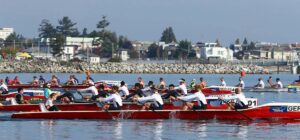Today’s Rowperfect tip for coaches is about power during the stroke and how to dponstrate to your crews what they need to do to keep the boat speed as they raise the rating. It’s designed to be a short training session – maybe 15-20 minutes per athlete group.
Mike Spracklen says the fastest crews have 3 things: Long Stroke Length, High Rating, Top Power.
This drill will help you teach your crew how to maintain these three when under pressure in a race.
Set up the Rowperfect computer software to display on top row (joules, length, rate) and second row (split, watts).


- joules
- stroke length
- stroke rate
- 500m split
- watts
If you have a tpplate force curve saved that you want your crew to work towards, load this up. Here’s some top international rowers curves for you to download.
Give the athletes a target joules number to row to.
Explain that joules shows the base energy they are putting into spinning the flywheel. Unlike watts (joules per second) it does nto change when the stroke rate changes and so will show whether the athlete is successfully putting the same amount of energy into spinning the flywheel when the rate changes (or not). Video explaining difference watts and joules.
Target joules suggestions
- Heavyweight men (club = 850-900); international = 1000 joules)
- Heavyweight women (club = 550 – 600, international = 650 joules)
- Lightweight men (club = 650-700, international 750 joules)
- Lightweight women (club = 450 – 500, international = 550 joules)
- Juniors – adjust the above downwards to reflect age, strength and experience.
You’ll quickly work out whether your crew can successfully hold these numbers and whether to adjust targets up or down.
Instruct the athletes that they are going to row a set of stairs/ladders i.e. 10 strokes at each rate, then take the rate up 2 and do another 1o strokes. Start at rate 20 and go up to 30; then after a rest, do a second set starting at 24 and go up to 34.
Tell your athletes to keep the same force curve, same joules and same stroke length while they go up in rate.
Observe the numbers they pull.
You should see the watts go up and the 500m split go down as each step in rate happens. This is the same as you’d see on a Concept2 ergo.
But look at the joules, stroke length and force curve. Are they staying the same? You’ll only get these on a Rowperfect.
- Is the curve getting distorted at higher rates?
- Are the joules dropping at higher rates?
- Is the stroke length shortening at higher rates?
Each of these is a sign that your crew’s boat will be going slower as they take the rate up in a race if they row like this.
Your coaching challenge
Teach your athletes how to maintain stroke length, force curve shape and joules target through the range of stroke rates they’ll be doing in the boat during a race.
This drill will also help you select your crew because you can clearly see which athletes can hold their technique and form at higher rates and which ones ‘lose it’ when they are challenged by the increased rate.








This Post Has 4 Comments
Interesting training concept, ill try doing this “test” myself.
I did want to clarify in my head one point about the joules per stroke (more for a sanity check than anything else). I understand the concept that as the rate comes up or goes down the Joules per stroke should stay constant if youre “working” as hard, i.e. so if you were going flat out it should be the same number of joules at 30 as it is at 20, however I wanted to get my head around the idea of how the length of the workout comes into this?
Part of my thinking on this came from when I read this on Carlos’ blog
http://www.carlosdinares.com/carlos-dinares-tip-402-coaching-rowing-to-win-this-is-my-top-secret/
“Using the average joules for a 2k and then exceeding this in low rate pieces by 50 or 100 Joules. I always have the rule of more joules per stroke in every stroke we take in training , every time, than any we take during a race”
Initially I read that as all low rate pieces should be done in this way, however after thinking about it some more I now assume he means if you were doing a low rate 2k, rather than any low rate piece you were doing (16km for example) since really if you were going flat out at 32spm for 2000m and that was your maximal average Joules per stroke, if you were equally as effective at 20spm and did the same average Joules per stroke for 2000m at 20spm that would also be your maximal? Is that correct?
Tom,
I’ve written to Carlos to ask his clarification.
My understanding of this is that this is INDEPENDENT of the length of workout.
i.e. you should be trying to do this all the time whether it’s a long UT2 session or sprint starts.
So you are always training at a energy (joules) output that is higher then you’ve previously achieved in on-water 2k races.
So you are not correct in trying to re-calculate the average joules based on the rating – Carlos intends his athletes to train to a high energy output all the time.
But I’ll wait for his word to confirm that I am right on this!
Rebecca
Tom, Carlos has recorded an answer for you in YouTube.
For what it’s worth, the method he describes is how Juri Janssen calculated the stroke rate he’d need to do the Athens Olympic 1x final in order to win. He based his calculations on joules per stroke. Here’s the blog post we wrote about Juri.
That does make sense as the additional rest would mean you could produce the Joules per stroke for a longer time than you do in a 2k at 30+ spm, thanks for clarifying